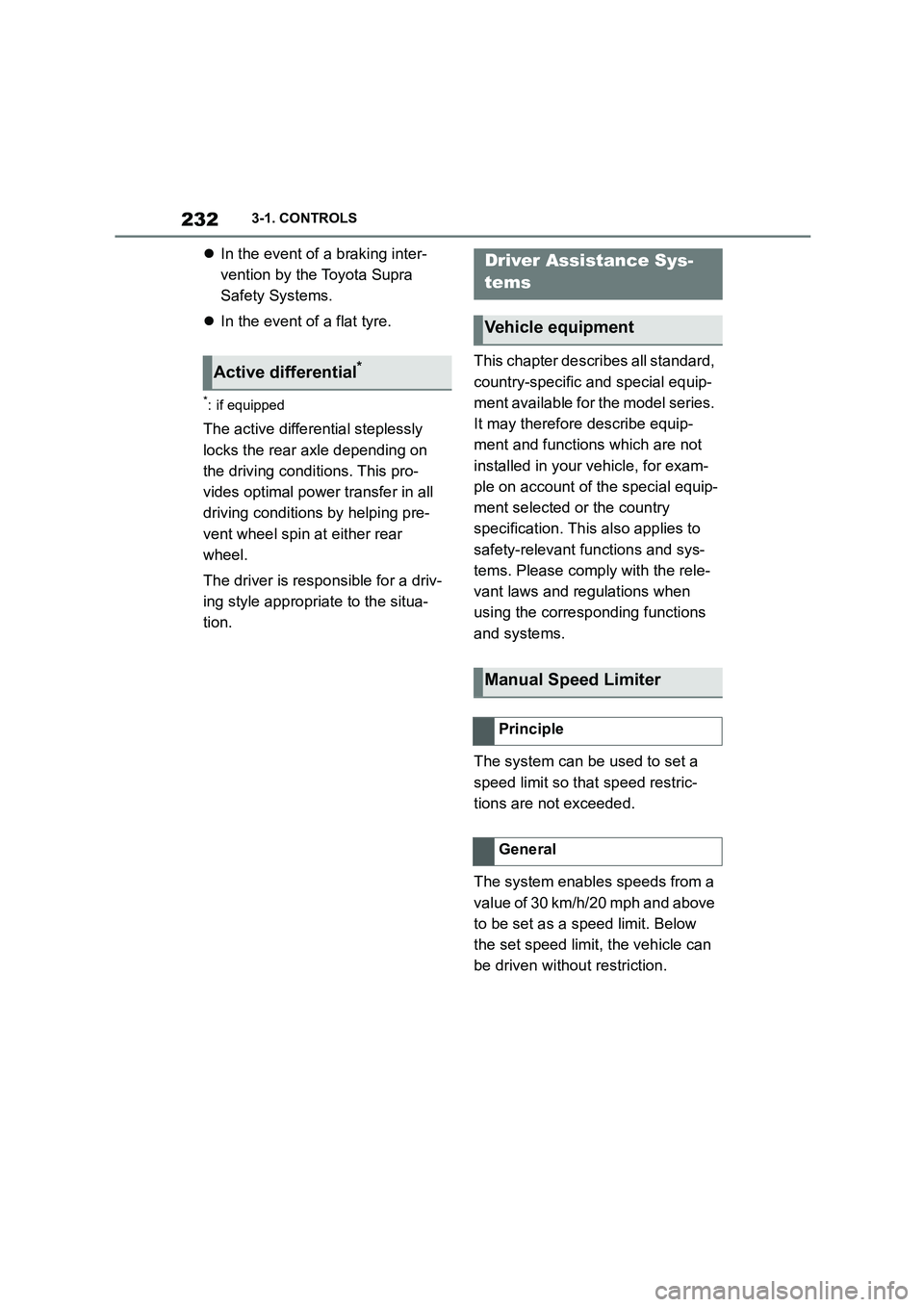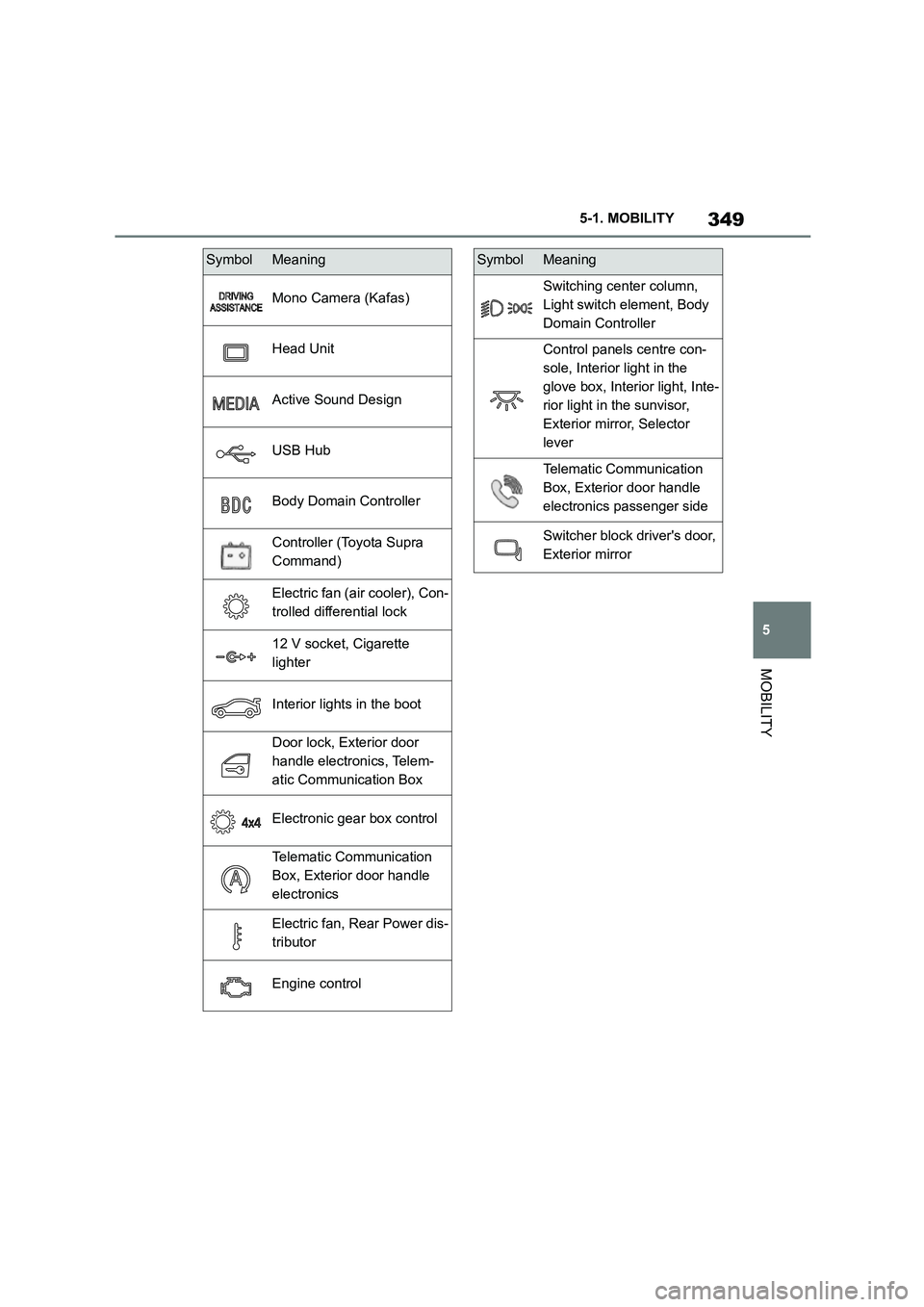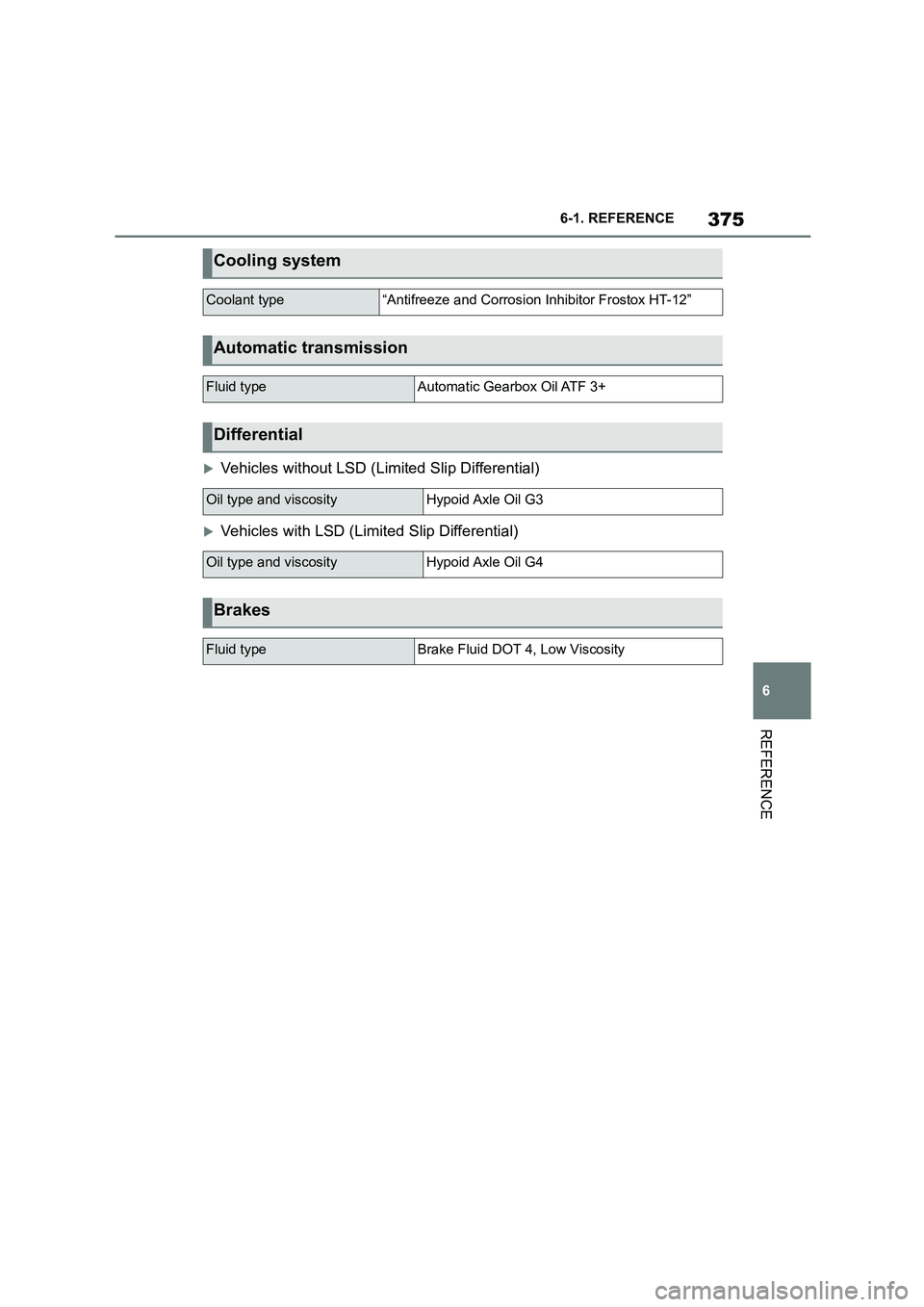2022 TOYOTA SUPRA differential
[x] Cancel search: differentialPage 212 of 498

2103-1. CONTROLS
An advance warning is given for
example if there is an impending
risk of collision or the distance from
the vehicle ahead is too short.
The driver must intervene person-
ally if there is an advance warning.
An acute warning is given when the
vehicle is approaching another
object at a high differential speed
and there is an immediate risk of a
collision.
The driver must intervene person-
ally if there is an acute warning.
Depending on the driving situation
and the vehicle's equipment, the
acute warning may be supported by
a brief jolt in the brakes.
If the warning time setting is "Late",
the jolt does not occur.
If necessary, the system can also
assist by braking the vehicle auto-
matically if there is a risk of a colli-
sion.
An acute warning can be triggered
even without a previous advance
warning.
The warning prompts the driver to
intervene actively. When the brake
is operated during a warning, the
maximum necessary braking force
is applied. Braking assistance
requires that the brake pedal is
depressed sufficiently quickly and
firmly beforehand.
The system can also assist by brak-
ing the vehicle automatically if there
is a risk of a collision.
At low speeds, the vehicle can be
braked to a stop.
City braking function: brake inter-
vention takes place at up to approx.
85 km/h, 53 mph.
With radar sensor: brake interven-
tion takes place at up to approx.
250 km/h, 155 mph.
At speeds above approx. 210 km/h,
130 mph, the brake intervention
takes the form of a brief jolt. There
is no automatic deceleration.
A brake intervention can be discon-
tinued either by depressing the
accelerator pedal or by actively
moving the steering wheel.
The detection of objects may be
limited. Take in to account the
detection range limits and the func-
tional limitations.
Advance warning
Acute warning with braking func-
tion
Brake intervention
Page 234 of 498

2323-1. CONTROLS
In the event of a braking inter-
vention by the Toyota Supra
Safety Systems.
In the event of a flat tyre.
*: if equipped
The active differential steplessly
locks the rear axle depending on
the driving conditions. This pro-
vides optimal power transfer in all
driving conditions by helping pre-
vent wheel spin at either rear
wheel.
The driver is responsible for a driv-
ing style appropriate to the situa-
tion.
This chapter describes all standard,
country-specific and special equip-
ment available for the model series.
It may therefore describe equip-
ment and functions which are not
installed in your vehicle, for exam-
ple on account of the special equip-
ment selected or the country
specification. This also applies to
safety-relevant functions and sys-
tems. Please comply with the rele-
vant laws and regulations when
using the corresponding functions
and systems.
The system can be used to set a
speed limit so that speed restric-
tions are not exceeded.
The system enables speeds from a
value of 30 km/h/20 mph and above
to be set as a speed limit. Below
the set speed limit, the vehicle can
be driven without restriction.
Active differential*
Driver Assistance Sys-
tems
Vehicle equipment
Manual Speed Limiter
Principle
General
Page 351 of 498

349
5
5-1. MOBILITY
MOBILITY
Mono Camera (Kafas)
Head Unit
Active Sound Design
USB Hub
Body Domain Controller
Controller (Toyota Supra
Command)
Electric fan (air cooler), Con-
trolled differential lock
12 V socket, Cigarette
lighter
Interior lights in the boot
Door lock, Exterior door
handle electronics, Telem-
atic Communication Box
Electronic gear box control
Telematic Communication
Box, Exterior door handle
electronics
Electric fan, Rear Power dis-
tributor
Engine control
SymbolMeaning
Switching center column,
Light switch element, Body
Domain Controller
Control panels centre con-
sole, Interior light in the
glove box, Interior light, Inte-
rior light in the sunvisor,
Exterior mirror, Selector
lever
Telematic Communication
Box, Exterior door handle
electronics passenger side
Switcher block driver's door,
Exterior mirror
SymbolMeaning
Page 377 of 498

375
6
6-1. REFERENCE
REFERENCE
Vehicles without LSD (Limited Slip Differential)
Vehicles with LSD (Limited Slip Differential)
Cooling system
Coolant type“Antifreeze and Corrosion Inhibitor Frostox HT-12”
Automatic transmission
Fluid typeAutomatic Gearbox Oil ATF 3+
Differential
Oil type and viscosityHypoid Axle Oil G3
Oil type and viscosityHypoid Axle Oil G4
Brakes
Fluid typeBrake Fluid DOT 4, Low Viscosity
Page 488 of 498

486Alphabetical Index
Compartments in the doors......... 274
Compressor .................................. 300
Condensation when vehicle is
parked ......................................... 285
Condition Based Service CBS..... 330
Connection point, starting assis-
tance ............................................ 358
Connections, Screen Mirroring ..... 85
Continuing a journey with a flat tyre
..................................................... 311
Control Display ............................... 59
Control Display, settings ............... 71
Control systems, driving stability228
Controller ........................................ 60
Coolant .......................................... 327
Coolant level ................................. 327
Coolant temperature .................... 169
Cooling effect, maximum............. 263
Cooling function ........................... 262
Cooling system ............................. 327
Cornering light .............................. 188
Corrosion of brake discs ............. 285
Cruise Control with distance control,
see Dynamic radar cruise control
..................................................... 238
Cruise Control without distance con-
trol, see Cruise Control ............. 234
Cruise Control, active with Stop &
Go ACC........................................ 238
Cruise Control, see Cruise Control
..................................................... 234
Cruise control, see Dynamic radar
cruise control ............................. 238
Cupholder ..................................... 275
Curtain shield airbag.................... 193
Customize settings, see Sport mode
switch .......................................... 160
D
Damage, tyres ............................... 295
Data protection, settings ............... 75
Data, see Deleting personal data .. 75
Data, technical .............................. 370
Date.................................................. 72
Daytime driving lights ..................187
Deactivation, airbags.................... 202
Deleting personal data ................... 75
Deletion of personal data ............... 75
Departure time, auxiliary heating 268
Departure time, independent ventila-
tion ............................................... 268
Desired speed, see Dynamic radar
cruise control..............................238
Devices, managing ......................... 86
Diagnosis connection ..................332
Diesel particle filter, see Exhaust gas
particle filter ................................281
Differential oil ................................375
Dimensions ...................................370
Dimmable exterior mirrors ........... 118
Dimming rear-view mirror ............ 118
Dipping headlights, see Automatic
high-beam ...................................188
Direct selection buttons, see Favour-
ites buttons ................................... 68
Display in windscreen, see Head-Up
Display.........................................182
Display lighting, see Instrument
lighting ........................................191
Displaying the device list ............... 86
Displays .........................................162
Displays and symbols ......................4
Displays, screens ......................... 368
Disposal, coolant ..........................328
Disposal, vehicle battery.............. 343
Disposing of the battery...............343
Disposing of the old battery ........ 343
Distance warning, see Parking Sen-
sors ..............................................248
Downhill gradients........................285
Drive mode, see Sport mode switch
..................................................... 160
Driver assistance, see Toyota Supra
Safety...........................................205
Driver Attention Control ...............226
Driver profiles ................................. 76
Drive-ready state, idle state and
standby state ................................ 53